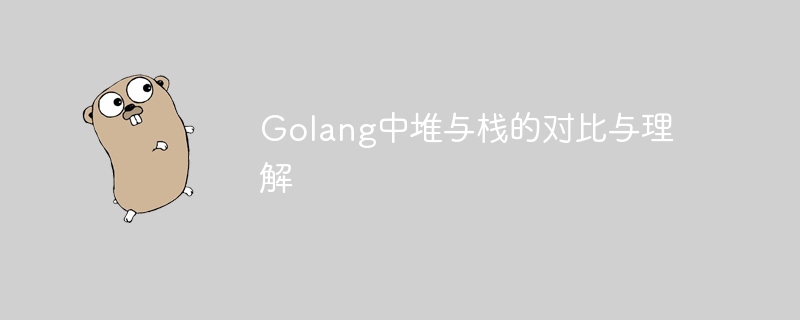Home >Backend Development >Golang >Comparison and understanding of heap and stack in Golang
Comparison and understanding of heap and stack in Golang
- WBOYWBOYWBOYWBOYWBOYWBOYWBOYWBOYWBOYWBOYWBOYWBOYWBOriginal
- 2024-03-13 21:48:041078browse

Comparison and understanding of heap and stack in Golang
When learning and using the Golang programming language, understand the principles of heap and stack and their role in memory management is very important. Heap and stack are two different ways of storing data. They have obvious differences in allocating, managing and releasing memory. This article will deeply explore the comparison between heap and stack in Golang, and help readers better understand the differences and connections between the two through specific code examples.
Definition of heap and stack
Heap and stack are the two main ways to store data in the operating system. In computer programming, the heap and stack are memory areas used to store data needed when the program is running. They have different characteristics when allocating and managing memory.
- Stack: The stack is a linear data structure that adopts the first-in, last-out principle. When the program is running, local variables, function parameters, return addresses, etc. are stored in the stack. The allocation and release of memory on the stack are performed automatically and are managed by the compiler. The stack size is usually small, but the access speed is very fast.
- Heap: The heap is a non-linear data structure used to store dynamically allocated memory. When the program is running, dynamically created variables and objects are stored in the heap. Developers need to manually allocate and release memory on the heap, and they need to pay attention to issues such as memory leaks. The size of the heap is relatively large, but the access speed is relatively slow.
Heap and stack in Golang
In Golang, the management of heap and stack is different from other programming languages. Golang's heap is managed by a garbage collector, and memory that is no longer used is automatically recycled through a mark and clear algorithm. The stack is managed by Golang's runtime system. The size of the stack is usually fixed and cannot be dynamically allocated like the heap.
Comparison between heap and stack
- Data storage method: The stack uses a first-in-last-out method to store data, while the heap dynamically allocates memory to store data.
- Allocation and Release: The allocation and release of memory on the stack are performed automatically and are managed by the compiler; while the allocation and release of memory on the heap require manual operations.
- Size: The size of the stack is usually small, while the size of the heap can be adjusted dynamically.
Code Example
The following is a specific code example to show the comparison between heap and stack in Golang:
package main
import "fmt"
func main() {
// 在栈中分配一个整型变量
var a int = 10
// 在堆中分配一个整型指针变量
b := new(int)
*b = 20
fmt.Println("栈中的变量 a 值为:", a)
fmt.Println("堆中的变量 b 值为:", *b)
// 释放堆中的内存
free(b)
}
func free(ptr *int) {
fmt.Println("释放堆中的变量")
// 释放堆中的内存
*ptr = 0
}In the above example, the variable a is allocated on the stack, while the variable b is dynamically allocated on the heap. In the main() function, we can see the comparison between the variable a in the stack and the variable b in the heap, and how to release the memory in the heap.
Conclusion
Through the above comparison and code examples, I hope readers can better understand the functions and differences between heap and stack in Golang. During the programming process, rational use of the heap and stack is of great significance for memory management and program performance optimization. It is recommended that readers practice more in actual projects and deeply understand the principles of heap and stack to write Golang programs more efficiently.
The above is the detailed content of Comparison and understanding of heap and stack in Golang. For more information, please follow other related articles on the PHP Chinese website!

